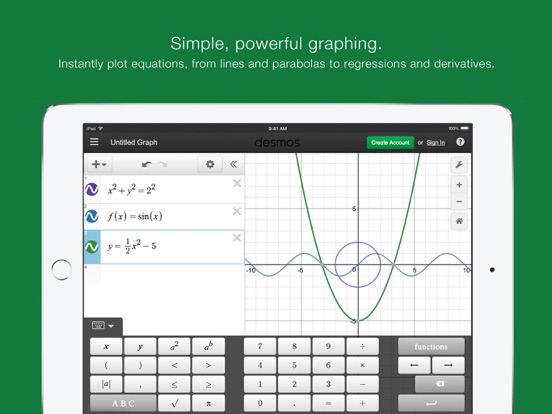

Reduced row echelon form (rref) can be used to find the inverse of a matrix, or solve systems of equations.Īlso with the same interface as the Scientific Calculator, it's as simple as it gets. You can multiply matrices, inverse them, raise them to powers, and transpose them (by using the A T button). Pressing the button 'New Matrix' makes a new matrix you can control the size of - up to 6 columns and 6 rows. Not much to be said here either, following the same interface as the Scientific Calculator, the Matrix Calculator is specialized in Matrix mathematics. The Scientific Calculator features variables, trig functions, simple statistical functions and other advanced functions. Simple said, it's an intuitively designed scientific calculator you might describe it as the Graphing calculator without the graphs and expressions, since all of the functions of the Scientific Calculator are available in the Graphing Calculator. Each construction requires some construction input, which are shown in brackets in the following list of transformations: Transformations that apply to constructions you made, they duplicate said constructions but modified. There are thirteen tools used in construction: The features of Geometry fall into two main categories: I'm sure you can think of plenty uses for this powerful tool: from demonstrating the Pythagorean theorem, to demonstrating constructions involving rulers and pairs of compasses.

To get started with the Desmos Graphing Calculator, check the 'Example' graphs found in the sidebar of the Graphing Calculator.īeing the newest member to the family, Geometry is used to show geometric constructions that features side lengths, angles and other features of shapes. There are also quality of life features such as: Statistical Distributions and Functions and Probability Functions.Parametric, Implicit and Polar Equations.Various Types of Mathematical Expressions, including:.Here are some of the features of the Graphing Calculator that, when combined together, create limitless possibilities: With Desmos, you can teach about fundamental mathematical theories using sliders, variables and animations all built into Desmos. If you change an earlier expression, the “ans” value updates automatically.Being the most popular of the family, the Desmos Graphing Calculator is a powerful tool for illustrating mathematical rules. The “ans” key always holds the value of your last computation so that you never have to remember or copy a result. Unlike many scientific calculators, all of your previous work remains visible on the screen. Assign values to variables for later use. Create and evaluate your own functions using familiar function notation. Works offline, no internet connection required. Statistics: Compute the mean and standard deviation (sample or population) of a list of data.Ĭombinatorics: Count combinations and permutations and calculate factorials. Trigonometry: Evaluate the fundamental trigonometric functions and their inverses, using either radians or degrees for angle measure. It’s intuitive, beautiful, and completely free.Īrithmetic: In addition to the basic operations, the scientific calculator also supports exponentiation, radicals, absolute value, logarithms, rounding, and percentages. To that end, we’ve built a simple yet powerful scientific calculator that runs on the same blazingly fast math engine as our next-generation graphing calculator, but with a more streamlined set of features, for those times when you just don’t need a graph. Or, define and evaluate your own functions - all for free.Īt Desmos, we imagine a world of universal math literacy where math is accessible and enjoyable for all students. Move beyond arithmetic with the Desmos scientific calculator! In addition to the basic operations, take advantage of a variety of built-in functions for exploring trigonometry, statistics, combinatorics, and more.


 0 kommentar(er)
0 kommentar(er)
